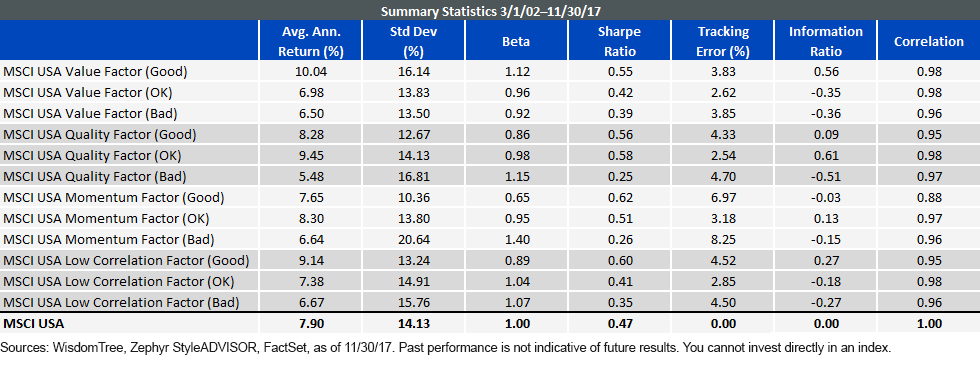MSCI USA Index Factor Attribution: What Worked?




Lately, investors have begun to accept smart beta—and factor investing—just as they did broad beta index funds years ago. WisdomTree pioneered the commercialization of these factor-based strategies with its dividend- and earnings-weighted products over a decade ago, but it also has spent the last few years improving its research around multifactor strategies more directly. One of the by-products of that research was the launch of the WisdomTree U.S. Multifactor Fund (USMF) in June 2017, which illustrates WisdomTree’s views on how to construct and effectively implement factor investing in a holistic fashion. Though USMF is a multifactor strategy, its four factor-based alpha signals—value, quality, momentum and low correlation—ultimately possess their own methodology via unique fundamental or technical indicators. Read more about what’s under the hood of USMF here.
WisdomTree’s research leads us to believe that the engineering behind USMF makes for an excellent measure of factor exposure among equity markets, so we applied a custom-fit version of our methodology to a well-known beta index: the MSCI USA Index. The purpose of this exercise was to isolate the performance of the MSCI USA Index, attributing factor performance to four factors, each with three different layers of factor concentration, all of them market cap-weighted. For example:
- MSCI USA Value Factor (Good) represents the best MSCI USA stocks ranked by WisdomTree’s value methodology, and one-third of the total market cap of the index.
- MSCI USA Value Factor (OK) represents the next group of value-ranked stocks that fall into a second but equal market cap grouping.
- MSCI USA Value Factor (Bad) is the lowest-ranked value stocks that fall into a third but equal market cap group.
This same approach then repeats itself among the other three factors to better understand the factor performance composition of the MSCI USA Index over the past 15+ years.

- On a risk-adjusted (Sharpe ratio) and absolute return basis, all four Good baskets outperformed their Bad counterparts.
- Three out of four Good baskets reduced volatility, measured by both standard deviation and beta, except for Good Value.
- Tracking error for Good and Bad baskets generally gravitated around 4% to 8% as they access either the higher/lower volatility or higher/lower performance parts of the markets, while OK baskets generally tracked tighter to the 3% range.
- Each Bad basket exhibited the worst absolute and risk-adjusted returns of its factor grouping, including underperformance versus the complete MSCI USA Index on an absolute and risk-adjusted basis.
Long/Short Factors vs. Long Only
The last bullet point above is important. New factor investors might not realize that most academics who herald long-term excess return “factor premiums” are actually operating in a long/short framework. In our example, this would be more akin to the factor premium being the excess return between a Good and a Bad basket, rather than just the Good basket by itself. Yet, given that many modern smart beta and factor investors utilize long-only approaches, this research provides credibility to their thinking. By isolating only Good factor exposures, you may not be shorting the Bad ones, but you are certainly avoiding them. Above, we showed how not one of the Bad baskets managed to outperform the MSCI USA Index on an absolute or risk-adjusted basis, meaning that investing in those groups of stocks would have been a performance drag over the period shown here.
Conclusion
On a high level, what does this research tell us? By using WisdomTree’s factor methodology to isolate factor performance, factor investing has worked. Using the MSCI USA Index, we found attractive results among the Good baskets of each of our four factors, while also observing poor results among the Bad. We believe this difference represents the core concept of factor investing and should be understood by new smart beta entrants. We also believe this research provides efficacy to long-only factor investing as a long-term strategy rather than as a temporary investment fad. Along with U.S.-based factor analysis, WisdomTree has conducted factor research across the globe that we are excited to share. Stay tuned.
Important Risks Related to this Article
There are risks associated with investing, including possible loss of principal. Investing in a Fund exposed to particular sectors increases the vulnerability to any single economic, political or regulatory development. This may result in greater share price volatility. Due to the investment strategy of the Fund, it may make higher capital gain distributions than other ETFs. Please read the Fund’s prospectus for specific details regarding the Fund’s risk profile.



Alejandro Saltiel joined WisdomTree in May 2017 as part of the Quantitative Research team. Alejandro oversees the firm’s Equity indexes and actively managed ETFs. He is also involved in the design and analysis of new and existing strategies. Alejandro leads the quantitative analysis efforts across equities and alternatives and contributes to the firm’s website tools and model portfolio infrastructure. Prior to joining WisdomTree, Alejandro worked at HSBC Asset Management’s Mexico City office as Portfolio Manager for multi-asset mutual funds. Alejandro received his Master’s in Financial Engineering degree from Columbia University in 2017 and a Bachelor’s in Engineering degree from the Instituto Tecnológico Autónomo de México (ITAM) in 2010. He is a holder of the Chartered Financial Analyst designation.

